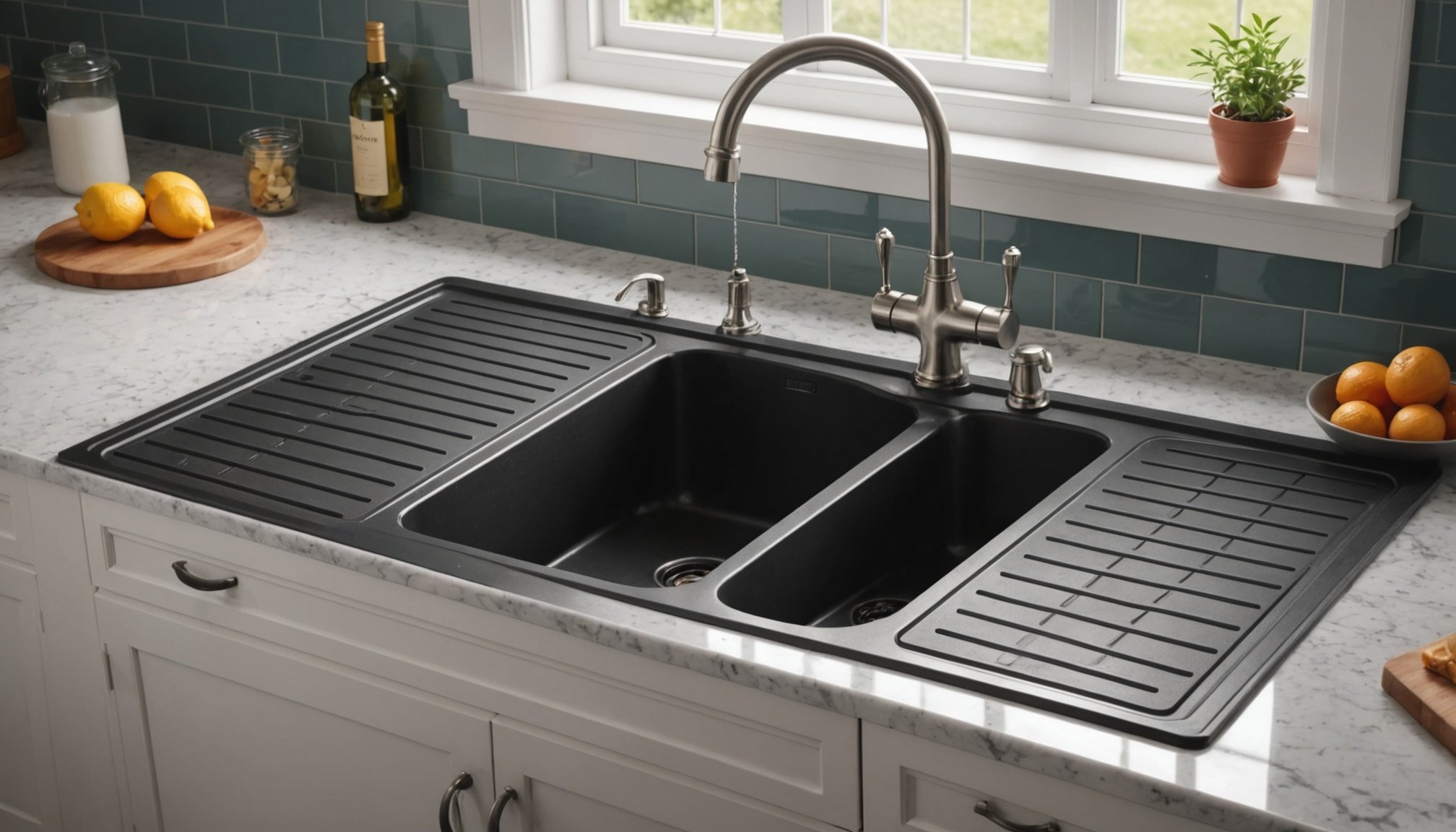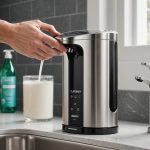Choosing the right draining board material is essential for maintaining a spotless kitchen. Water spots and mineral buildup can create an unsightly mess, impacting both hygiene and aesthetics. This guide reveals the best materials designed to repel water stains and prevent mineral accumulation. Explore innovative options that not only keep your kitchen looking its best but also enhance its functionality. Discover how to make an informed choice that benefits your daily routine.
Overview of Draining Board Materials
Understanding the variety of draining board materials is essential for selecting the best option for your kitchen needs. The most common types of draining boards include stainless steel, plastic, wood, and composite materials. Each material offers unique benefits and considerations.
Also read : Unleash bold flavors with maille mustard in your kitchen
Stainless steel is known for its durability and resistance to rust, making it a popular choice for modern kitchens. It offers a sleek, contemporary look but can be prone to scratches. Plastic draining boards are lightweight and affordable, ideal for those on a budget. However, they may lack the longevity of other materials.
Wooden draining boards provide a warm, natural aesthetic and are gentle on delicate dishes. They require regular maintenance to prevent water damage. Composite materials, such as granite or quartz, combine durability with a stylish appearance but may come at a higher cost.
In parallel : Essential Considerations for Choosing the Perfect Electric Griddle for Memorable Family Breakfasts
Importance of Material Selection
Choosing the right draining board material is crucial for functionality and longevity. Consider factors like kitchen style, budget, and maintenance when making your decision. A well-chosen material enhances both the aesthetic and practical aspects of your kitchen.
- Stainless steel: Durable, rust-resistant
- Plastic: Lightweight, budget-friendly
- Wood: Natural look, requires maintenance
- Composite: Durable, stylish, higher cost
Effectiveness in Minimizing Water Spots and Mineral Buildup
Exploring how materials handle water spots and mineral buildup can guide your choice.
Water spots prevention is a key factor when selecting a draining board material. Stainless steel excels in resisting water spots due to its smooth surface, which allows water to run off easily. However, it can show fingerprints and requires regular cleaning to maintain its shine. Plastic materials, while affordable, often struggle with water spots, as their surfaces can retain water, leading to unsightly marks.
Mineral buildup is another consideration. Composite materials like granite or quartz are less prone to mineral deposits, thanks to their non-porous nature. This makes them a practical choice for homes with hard water. On the other hand, wood can be susceptible to both water spots and mineral buildup, necessitating regular oiling and maintenance to prevent damage.
Comparative Effectiveness
In real-world scenarios, stainless steel and composite materials outperform others in minimizing both water spots and mineral buildup. Here's a quick comparison:
- Stainless Steel: High resistance to water spots, moderate mineral buildup prevention
- Plastic: Low resistance to both water spots and mineral buildup
- Wood: Moderate resistance, high maintenance required
- Composite: Excellent resistance, low maintenance
Choosing the right material ensures both functionality and ease of maintenance.
Pros and Cons of Popular Draining Board Materials
Evaluating the balance between benefits and drawbacks of each material can lead to an informed choice.
Stainless Steel
Stainless steel offers significant durability and resistance to rust, making it a reliable choice for long-term use. However, its sleek surface can be prone to scratches and may require regular cleaning to maintain its aesthetic appeal.
Pros:
- Highly durable
- Rust-resistant
Cons:
- Prone to scratches
- Requires maintenance for aesthetics
Plastic and Acrylic
Plastic and acrylic are known for their affordability, making them accessible options for budget-conscious consumers. Despite this, their longevity is often compromised, as they may not withstand heavy use over time.
Pros:
- Cost-effective
- Lightweight
Cons:
- Less durable
- Susceptible to wear
Natural Stone
Natural stone draining boards, such as granite or quartz, are celebrated for their beauty and elegant appearance. However, they present maintenance challenges, needing regular sealing to prevent stains and damage.
Pros:
- Aesthetic appeal
- Durable
Cons:
- High maintenance
- Expensive
Understanding these pros and cons helps in selecting a material that aligns with both your kitchen's style and practical needs. Balancing durability and aesthetics with affordability and maintenance challenges ensures a satisfying choice.
Maintenance Tips for Different Draining Board Materials
Keep your draining boards in top condition with these tailored care instructions.
Best Cleaning Practices
For stainless steel, regular cleaning with a mild detergent and warm water is essential. To avoid scratches, use a soft cloth or sponge. For plastic draining boards, a mix of vinegar and water can effectively remove stains and odors. Ensure thorough drying after cleaning to prevent water spots.
Recommended Products for Natural Stone
Maintaining natural stone like granite or quartz requires special care. Use pH-neutral cleaners specifically designed for stone surfaces. Avoid acidic or abrasive products to preserve the stone's finish. Regular sealing, typically every six months, is crucial to prevent stains and damage.
Frequency of Maintenance
Different materials demand varying maintenance frequencies:
- Stainless Steel: Weekly cleaning to maintain shine and prevent buildup.
- Plastic: Clean as needed, typically weekly, to avoid discoloration.
- Natural Stone: Clean weekly, with biannual sealing.
Draining board maintenance is key to prolonging the life and look of your kitchen surfaces. By following these cleaning tips and care instructions, you ensure that each material remains both functional and aesthetically pleasing. Regular attention to maintenance ensures longevity and performance, keeping your kitchen in pristine condition.
User Reviews and Experiences
Gather insights from real-life experiences to guide your choice.
Summary of User Feedback
User reviews on various draining board materials reveal diverse opinions shaped by individual experiences. Stainless steel is frequently praised for its sleek appearance and durability, though some users mention its susceptibility to scratches. Plastic options receive mixed feedback; while appreciated for affordability, users often report concerns about their longevity.
Common Issues Reported
Several common issues arise in user feedback. For wooden draining boards, users frequently mention the need for regular maintenance to prevent water damage. Composite materials, despite their stylish appeal, occasionally receive criticism due to their higher cost, which some users find prohibitive.
Recommendations Based on User Satisfaction
Based on user satisfaction, the following recommendations emerge:
- Stainless Steel: Ideal for those prioritizing durability and modern aesthetics.
- Plastic: Suitable for budget-conscious consumers, though expect limited longevity.
- Wood: Best for those who value natural aesthetics and are willing to invest in maintenance.
- Composite: Perfect for users seeking a blend of style and durability, despite the higher price.
User reviews provide valuable insights into the pros and cons of each material, helping potential buyers make informed decisions based on real-life experiences.
Expert Recommendations for Selecting Draining Board Materials
Expert advice can significantly enhance your decision-making process when selecting the right draining board material.
Insights from Design Professionals
Kitchen and bath design professionals emphasize the importance of aligning material selection with your kitchen's design and usage. Stainless steel is often recommended for contemporary styles, while wood suits rustic or traditional aesthetics. Plastic is suggested for budget-friendly renovations, and composite materials for luxury kitchens.
Recommendations for Specific Use Cases
In high moisture areas, experts advise choosing stainless steel or composite materials due to their resistance to water damage. For households with children, plastic is recommended for its lightweight and safe nature. Wood is best suited for kitchens where aesthetics outweigh practicality, given its maintenance needs.
Personal Preferences and Style
Your personal style plays a crucial role in material selection. If durability and a modern look are priorities, stainless steel is ideal. For those valuing a natural appearance, wood offers warmth and charm. Composite materials are perfect for a sophisticated, durable choice, while plastic caters to those seeking affordability.
- Stainless Steel: Modern, durable
- Plastic: Budget-friendly, lightweight
- Wood: Natural, high maintenance
- Composite: Stylish, durable
These professional recommendations help tailor material selection to your specific needs and preferences, ensuring a harmonious kitchen environment.
Visual Aids and Practical Advice for Specific Environments
Enhance your understanding of material choices with visual comparisons and tailored advice.
Charts Comparing Material Features
Understanding the distinct features and performance of draining board materials is crucial. Consider the following chart for a comparative overview:
| Material | Durability | Aesthetic | Maintenance | Cost |
|---|---|---|---|---|
| Stainless Steel | High | Modern | Moderate | Moderate |
| Plastic | Low | Versatile | Low | Low |
| Wood | Moderate | Natural | High | Moderate |
| Composite | High | Stylish | Low | High |
Images Showcasing Different Materials
Visual aids, such as images, can provide a clearer understanding of how each material fits into various environments. Stainless steel often complements modern kitchens, while wood adds warmth to rustic settings. Composite materials, with their elegant appearance, enhance luxury spaces.
Tailored Advice for Kitchen vs. Bathroom Installations
When considering specific environments, it's essential to tailor your choice. In kitchens, where durability and style are paramount, stainless steel or composite materials are recommended. For bathrooms, where moisture is a concern, plastic offers a lightweight and budget-friendly solution.
By using these visual aids and practical advice, you can confidently select the best material for your needs, ensuring both functionality and aesthetic appeal in your home.













